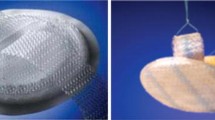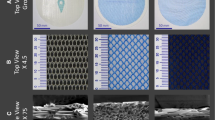Abstract
Purpose
Knowledge about the influence of underlying biomaterial on behavior of surgical meshes at the esophageal hiatus is rare, but essential for safe and effective hiatal hernia surgery. This study aimed to characterize the influence of polymer material on mesh behavior at the hiatus.
Methods
24 pigs in three groups of eight underwent implantation of either polypropylene (PP), polyester (PET) or polytetrafluoroethylene (PTFE) mesh placed circularly at the esophageal hiatus. After 8 weeks, necropsy and measurements were performed evaluating mesh deformation, adhesion formation, fixation of the esophagogastric junction and mesh position. Foreign body reaction was assessed by mononuclear cell count and immunostaining of Ki-67. Tissue integration was evaluated by immunostaining of type I and type III collagen fibers.
Results
Mesh shrinkage was the highest for PTFE, lower for PP and the lowest for PET (34.9 vs. 19.8 vs. 12.1 %; p = 0.002). Mesh aperture for the esophagus showed an enlargement within all groups, which was highest for PTFE compared to PP and PET (100.8 vs. 47.0 vs. 35.9 %; p = 0.001). The adhesion score was highest for PP, lower for PTFE and the lowest for PET (11.0 vs. 9.5 vs. 5.0; p = 0.001) and correlated positively with the score of esophagogastric fixation (r s = 0.784, p < 0.001). No mesh migration, erosion or stenosis of the esophagus occurred. Evaluation of foreign body reaction and tissue integration showed no significant differences.
Conclusions
In this experimental setting, PP-meshes showed the most appropriate characteristics for augmentation at the hiatus. Due to solid fixation of the esophagogastric junction and low shrinkage tendency, PP-meshes may be effective in preventing hiatal hernia recurrence. The use of PTFE-mesh at the hiatus may be disadvantageous due to high shrinkage rates and correlating enlargement of the aperture for the esophagus.





Similar content being viewed by others
References
Frantzides CT, Madan AK, Carlson MA, Stavropoulos GP (2002) A prospective, randomized trial of laparoscopic polytetrafluoroethylene (PTFE) patch repair vs simple cruroplasty for large hiatal hernia. Arch Surg 137:649–652
Müller-Stich BP, Holzinger F, Kapp T, Klaiber C (2006) Laparoscopic hiatal hernia repair: long-term outcome with the focus on the influence of mesh reinforcement. Surg Endosc 20:380–384. doi:10.1007/s00464-004-2272-6
Zaninotto G, Portale G, Costantini M, Fiamingo P, Rampado S, Guirroli E, Nicoletti L, Ancona E (2007) Objective follow-up after laparoscopic repair of large type III hiatal hernia. Assessment of safety and durability. World J Surg 31:2177–2183. doi:10.1007/s00268-007-9212-2
Schildberg CW, Perrakis A, Croner R, Schellerer V, Haupt W, Weidinger T, Hohenberger W, Horbach T (2012) Results of surgical treatment of hiatal hernia. Zentralbl Chir 139(1):66–71. doi:10.1055/s-0032-1315116
Furnée E, Hazebroek E (2013) Mesh in laparoscopic large hiatal hernia repair: a systematic review of the literature. Surg Endosc 27:3998–4008. doi:10.1007/s00464-013-3036-y
Lee E, Frisella MM, Matthews BD, Brunt LM (2007) Evaluation of acellular human dermis reinforcement of the crural closure in patients with difficult hiatal hernias. Surg Endosc 21:641–645. doi:10.1007/s00464-006-9117-4
Oelschlager BK, Pellegrini CA, Hunter J, Soper N, Brunt M, Sheppard B, Jobe B, Polissar N, Mitsumori L, Nelson J, Swanstrom L (2006) Biologic prosthesis reduces recurrence after laparoscopic paraesophageal hernia repair: a multicenter, prospective, randomized trial. Ann Surg 244:481–490. doi:10.1097/01.sla.0000237759.42831.03
Oelschlager BK, Pellegrini CA, Hunter JG, Brunt ML, Soper NJ, Sheppard BC, Polissar NL, Neradilek MB, Mitsumori LM, Rohrmann CA, Swanstrom LL (2011) Biologic prosthesis to prevent recurrence after laparoscopic paraesophageal hernia repair: long-term follow-up from a multicenter, prospective, randomized trial. J Am Coll Surg 213:461–468. doi:10.1016/j.jamcollsurg.2011.05.017
Müller-Stich BP, Mehrabi A, Kenngott HG, Fonouni H, Reiter MA, Kuttymoratov G, Nickel F, Linke GR, Wolf I, Köninger J, Gutt CN (2009) Is a circular polypropylene mesh appropriate for application at the esophageal hiatus? Results from an experimental study in a porcine model. Surg Endosc 23:1372–1378. doi:10.1007/s00464-008-0185-5
Smith GS, Hazebroek EJ, Eckstein R, Berry H, Smith WM, Isaacson JR, Falk GL, Martin CJ (2008) Evaluation of DualMesh for repair of large hiatus hernia in a porcine model. Surg Endosc 22:1625–1631. doi:10.1007/s00464-007-9669-y
Jansen M, Otto J, Jansen PL, Anurov M, Titkova S, Willis S, Rosch R, Ottinger A, Schumpelick V (2007) Mesh migration into the esophageal wall after mesh hiatoplasty: comparison of two alloplastic materials. Surg Endosc 21:2298–2303. doi:10.1007/s00464-007-9514-3
Otto J, Kämmer D, Jansen PL, Anurov M, Titkova S, Ottinger A, Rosch R, Schumpelick V, Jansen M (2008) Different tissue reaction of oesophagus and diaphragm after mesh hiatoplasty. Results of an animal study. BMC Surg 8:7. doi:10.1186/1471-2482-8-7
Desai KM, Diaz S, Dorward IG, Winslow ER, La Regina MC, Halpin V, Soper NJ (2006) Histologic results 1 year after bioprosthetic repair of paraesophageal hernia in a canine model. Surg Endosc 20:1693–1697. doi:10.1007/s00464-006-0680-5
Wolf I, Vetter M, Wegner I, Böttger T, Nolden M, Schöbinger M, Hastenteufel M, Kunert T, Meinzer H-P (2005) The medical imaging interaction toolkit. Med Image Anal 9:594–604. doi:10.1016/j.media.2005.04.005
Schreinemacher MHF, Emans PJ, Gijbels MJJ, Greve J-WM, Beets GL, Bouvy ND (2009) Degradation of mesh coatings and intraperitoneal adhesion formation in an experimental model. Br J Surg 96:305–313. doi:10.1002/bjs.6446
Anderson JM, Rodriguez A, Chang DT (2008) Foreign body reaction to biomaterials. Semin Immunol 20:86–100. doi:10.1016/j.smim.2007.11.004
Junge K, Binnebösel M, Rosch R, Jansen M, Kämmer D, Otto J, Schumpelick V, Klinge U (2009) Adhesion formation of a polyvinylidenfluoride/polypropylene mesh for intra-abdominal placement in a rodent animal model. Surg Endosc 23:327–333. doi:10.1007/s00464-008-9923-y
Rauth TP, Poulose BK, Nanney LB, Holzman MD (2007) A comparative analysis of expanded polytetrafluoroethylene and small intestinal submucosa—implications for patch repair in ventral herniorrhaphy. J Surg Res 143:43–49. doi:10.1016/j.jss.2007.03.079
Burger JWA, Halm JA, Wijsmuller AR, ten Raa S, Jeekel J (2006) Evaluation of new prosthetic meshes for ventral hernia repair. Surg Endosc 20:1320–1325. doi:10.1007/s00464-005-0706-4
Jacob DA, Schug-Pass C, Sommerer F, Tannapfel A, Lippert H, Köckerling F (2012) Comparison of a lightweight polypropylene mesh (Optilene® LP) and a large-pore knitted PTFE mesh (GORE® INFINIT® mesh)—Biocompatibility in a standardized endoscopic extraperitoneal hernia model. Langenbeck Arch Surg 397:283–289. doi:10.1007/s00423-011-0858-8
Cardarelli F (2008) Polymers and elastomers. In: Materials handbook, 2nd edn. Springer, London, pp 691–750
Shankaran V, Weber DJ, Reed RL 2nd, Luchette FA (2011) A review of available prosthetics for ventral hernia repair. Ann Surg 253:16–26. doi:10.1097/SLA.0b013e3181f9b6e6
Hill LD (1967) An effective operation for hiatal hernia: an 8 year appraisal. Ann Surg 166:681–692
Müller-Stich BP, Köninger J, Müller-Stich BH, Schäfer F, Warschkow R, Mehrabi A, Gutt CN (2009) Laparoscopic mesh-augmented hiatoplasty as a method to treat gastroesophageal reflux without fundoplication: single-center experience with 306 consecutive patients. Am J Surg 198:17–24. doi:10.1016/j.amjsurg.2008.07.050
Gouvas N, Tsiaoussis J, Athanasakis E, Zervakis N, Pechlivanides G, Xynos E (2011) Simple suture or prosthesis hiatal closure in laparoscopic repair of paraesophageal hernia: a retrospective cohort study. Dis Esophagus 24:69–78. doi:10.1111/j.1442-2050.2010.01094.x
Linke GR, Gehrig T, Hogg LV, Göhl A, Kenngott H, Schäfer F, Fischer L, Gutt CN, Müller-Stich BP (2014) Laparoscopic mesh-augmented hiatoplasty without fundoplication as a method to treat large hiatal hernias. Surg Today 44:820–826. doi:10.1007/s00595-013-0609-2
Tang L, Jennings TA, Eaton JW (1998) Mast cells mediate acute inflammatory responses to implanted biomaterials. Proc Natl Acad Sci USA 95:8841–8846
Franz S, Rammelt S, Scharnweber D, Simon JC (2011) Immune responses to implants—a review of the implications for the design of immunomodulatory biomaterials. Biomaterials 32:6692–6709. doi:10.1016/j.biomaterials.2011.05.078
Klinge U, Klosterhalfen B, Müller M, Ottinger AP, Schumpelick V (1998) Shrinking of polypropylene mesh in vivo: an experimental study in dogs. Eur J Surg 164:965–969. doi:10.1080/110241598750005156
Ten Hallers EJO, Jansen JA, Marres HAM, Rakhorst G, Verkerke GJ (2007) Histological assessment of titanium and polypropylene fiber mesh implantation with and without fibrin tissue glue. J Biomed Mater Res A 80:372–380. doi:10.1002/jbm.a.30887
Acknowledgments
We would like to thank Elizabeth Corrao for reviewing the manuscript as a native speaker. Furthermore, we would like to thank Covidien (Neustadt, Germany) and W.L. Gore & Associates (Newark, USA) for providing mesh samples for this study.
Conflict of interest
Drs. B.M., J.S., F.L., M.S., A.B., T.B., H.K., L.F., T.G. have no conflict of interest or financial ties to disclose.
Author information
Authors and Affiliations
Corresponding author
Additional information
B. P. Müller-Stich, and J. D. Senft have contributed equally.
Rights and permissions
About this article
Cite this article
Müller-Stich, B.P., Senft, J.D., Lasitschka, F. et al. Polypropylene, polyester or polytetrafluoroethylene—is there an ideal material for mesh augmentation at the esophageal hiatus? Results from an experimental study in a porcine model. Hernia 18, 873–881 (2014). https://doi.org/10.1007/s10029-014-1305-x
Received:
Accepted:
Published:
Issue Date:
DOI: https://doi.org/10.1007/s10029-014-1305-x




